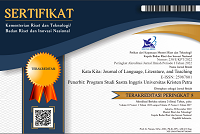Interactional Styles Used by Lucinta Luna In Episode 1 #TheFamily YouTube Series
DOI:
https://doi.org/10.9744/katakita.12.2.266-273Keywords:
Celebrity Endorser, Sosial media, Model TEARS, RespectAbstract
This study aims to examine the feminine interactional styles and masculine interactional styles used by Lucinta Luna in the YouTube video Terbongkar: Lucinta Keceplosan Alasan Ayu Ting Ting Tolak Boy! Episode 1 #TheFamily. Besides, the writer employed a qualitative approach using Holmes’ (2006) theory on feminine interactional styles and masculine interactional styles.Moreover, the writer collected all utterances of Lucinta Luna in her interaction with the host and the participants. The analysis presented Lucinta utilized both feminine and masculine interactional styles, but she used more feminine interactional styles. Nonetheless, she did not use one feature of masculine interactional style at all, which is aggressive interruptions. She used more feminine language, which was related to her gender as a trans woman.
References
Holmes, J. (2006). Gendered talk at work: Constructing social identity through workplace
interaction. Blackwell Publishing.
Holmes, J. (2013). An introduction to sociolinguistics. (4th ed.). Routledge.
Downloads
Published
Issue
Section
License
Authors who publish with this journal agree to the following terms:- Authors retain copyright and grant the journal right of first publication with the work simultaneously licensed under a Creative Commons Attribution License that allows others to share the work with an acknowledgement of the work's authorship and initial publication in this journal.
- Authors are able to enter into separate, additional contractual arrangements for the non-exclusive distribution of the journal's published version of the work (e.g., post it to an institutional repository or publish it in a book), with an acknowledgement of its initial publication in this journal.
- Authors are permitted and encouraged to post their work online (e.g., in institutional repositories or on their website) prior to and during the submission process, as it can lead to productive exchanges, as well as earlier and greater citation of published work (See The Effect of Open Access).














